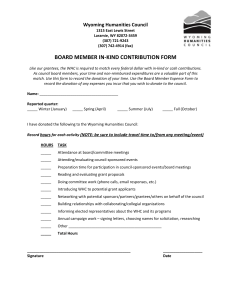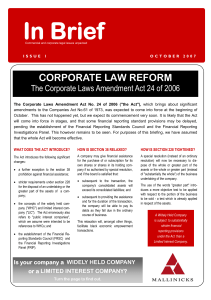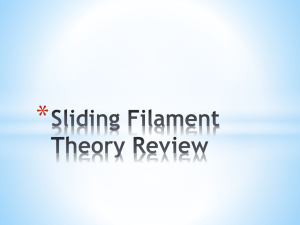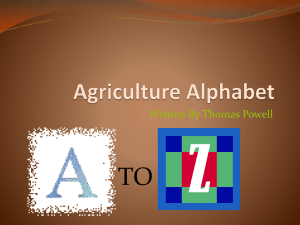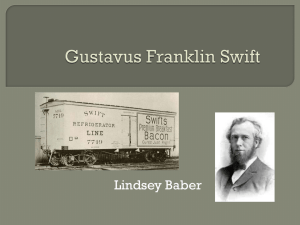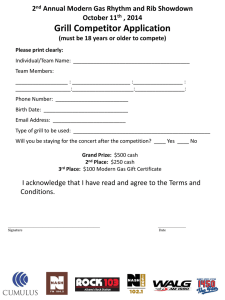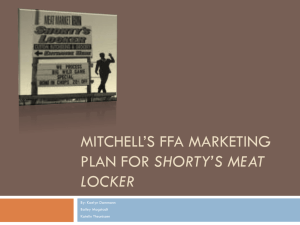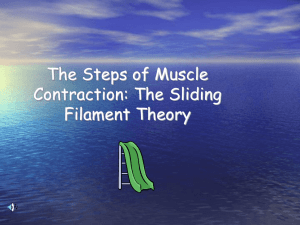PPT - University of Nairobi
advertisement
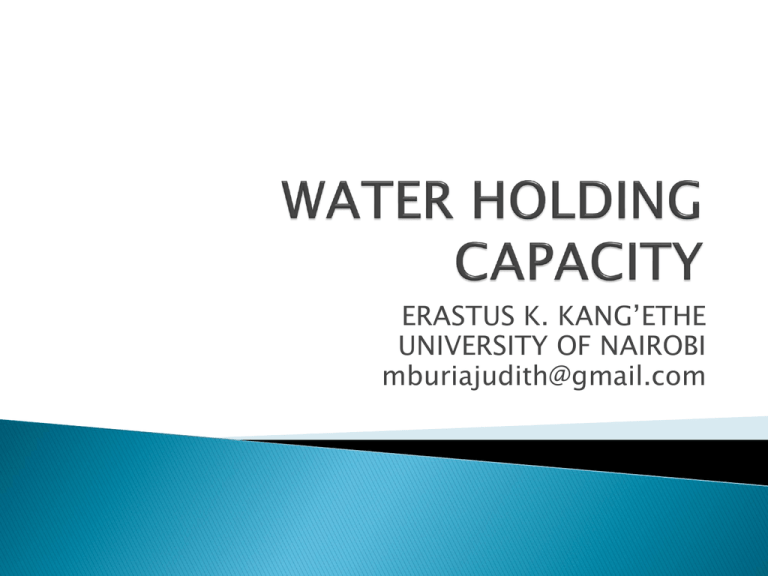
ERASTUS K. KANG’ETHE UNIVERSITY OF NAIROBI mburiajudith@gmail.com Muscle contains 75% water. Much is lost through drip (3-15%), evaporation (3%) and cooking(40%) Gains may also occur during processing (10%) Water loss is important for two reasons, 1) meat is sold by weight and 2)Water loss contains nutrient Water is held in meat in layers 5% is tightly bound 90-95% held loosely by weak forces H-bonding 2 Juiciness and tenderness of meat is affected by amount of water WHC is ability of muscle/meat to retain its own or added water. When meat takes up added water is referred to as swelling Water is held by capillary forces in the space between myofilaments. The space is called interfilamental space and varies between 320- 570 nm. 3 • • • • • This IFS is affected by pH, ionic strength, pre and post rigor factors and sarcomere length Most of the changes in water affects the loosely bound or free water IFS increase by three times results in a 6 fold increase in volume. There are constraints to unrestricted increase in IFS. Any changes to net charges on the myofilaments increases electrostatic attraction or repulsive forces 4 These are: negative forces on the protein at high pH, attachment of myosin to actin, Zdisk attachment of actin and attachment of myosin to M-line proteins Factors affecting WHC Fresh (uncooked meat) • Since pm glycolysis is typical in any muscle and proceeds to ultimate pH of 5.5, this pH coincidentally is the IP of principal meat proteins, loss of WHC is inevitable as a consequence of death • 5 • • • • Extent of post mortem fall in pH. At slaughter the pH is neutral, as pH reaches ultimate, this coincides with the IP of muscle proteins. The electrostatic forces decrease as the net negative charges decrease and this increases the attractive forces. At IP the net charge is zero and WHC is at minimum or lowest. Above the IP, net charge changes to be positive and WHC increases again. 6 The higher the ultimate pH the less the water lost. Sarcoplasmic proteins responsible for WHC are affected by pm fall in pH. ATP loss and following formation of actomyosin causes loss of WHC at any pH because WHC of actomyosin is less than that of myosin and actin The effect of the extent of pH fall on WHC is referred to as the net charge effect of WHC 7 Rate of post mortem fall in pH. Denaturation of sarcoplamic proteins is worsened the faster the rate of pH fall A fast rate (i.e of ATP breakdown) increases the tendency of actmyosin formation and this expresses water held in the IFS out as drip. PSE is a case in point of the effect of fast rate of pH fall at elevated body temperatures 8 ATP breakdown. As pm changes continue after slaughter, ATP is broken down. In muscle ATP is associated with Mg2+. These together with Ca2+ from sarcutubular system as ATP depletion progresses have the to combine with negatively charged reactive groups thus reducing the IFS and reducing WHC. These effects Are known as steric effects on WHC 9 Conditioning. AS meat is allowed to condition, some loss in WHC due to Pm glycolysis may be recovered. This is due to a rise in meat pH. However the slight rise may not account for the gain in WHC seen. The other possible reason id the proteolytic enzymes at PM that cause subtle changes in membrane permeability allowing diffusion and redistribution of ions. 10 Divalent cations like Mg2+ and Ca2+ being replaced by monovalent ion like K+. This causes repulsion and increase in IFS and therefore WHC. Processing. In curing salts are added. Of these the most important are the NaCl and polyphosphates. Addition of these causes swelling of fibers and uptake of water. 11 This swelling is limited by the structural constraints mentioned before. Cl- ions increase the net negative charge, cause electrostatic repulsion, increase IFS and hence WHC Swelling seen during curing is as a result of reduction in the structural constraints. Both salts cause extraction of the A-band, depolymerize myosin filaments and weaken the myosin head binding to actin 12 Heating. At 45-60oC, myofibrils are denatured and shrink. This leaves a gap between the fiber and surrounding endomysium. The gap becomes annular channels for water to get lost due to tension exerted on the water by the endomysium. 60-70oC, collagen is denatured, myofirils network shrinks further and more fliud is lost as the cooking loss (40%) 13 Drip. This loss is seen before cooking. At slaughter myofibrils are under tension from the endomysium. As PM glycolysis proceeds, ATP is lost, actomyosin bond is formed, pH falls and this decreases the electrostatic repulsion and reduces IFS. Gaps occur between the collagen and myofibril. The tension developed at rigor expels water through the gaps and is seen as drip. 14 Species. WHC of pork is higher than that of beef. This is a reflection of rate and extent of pH fall. Age. Age does not seem to influence WHC of pork but certainly in beef veal has higher WHC than beef. This too is a reflection of the rate and extent of pH fall. Between muscles there is a difference in WHC. This is possibly due to differences in glycogen content t and thus pH fall 15 Level of intramuscular fat. Muscles having high intramuscular fat have been shown to have a higher WHC. The reasons are unknown but possibly the fat loosens the microstructure allowing water to be retained. 16 Purpose i). Explain the effect of rate and extent of pH fall on WHC ii). Explain steric effect iii). Explain mechanism of how processing affects WHC iv). Explain how drip and cooking losses in WHC come about 17 References Meat Science by Lawrie, 4th Edition Principles of Meat Science by Forrest et al Hamm- water holding capacity in Meat edited by Cole and Lawrie. 18
